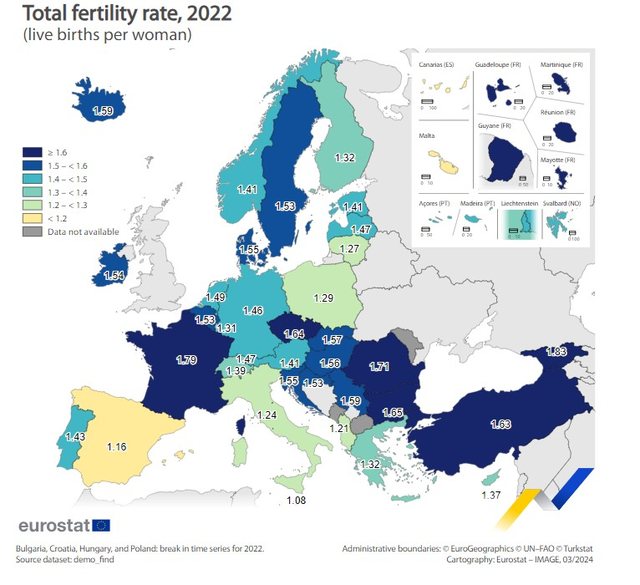
 Flash News
Flash News
A stable in Fier is engulfed in flames, agricultural equipment and haystacks are burned
Taulant Xhaka is introduced as a player-coach of the Albanian team in Switzerland
Iranian Foreign Minister Admits Serious Damage to Nuclear Power Plants
He bought votes for his daughter, SPAK takes the father of the PSD candidate to trial
Russia prepares summer offensive with help from North Korean troops in Ukraine
Albania with the lowest birth rate in Europe in 2022, leaving behind only Spain and Malta

Year after year, Albania is worsening its ranking in Europe in terms of fertility indicators for women.
Today's Eurostat data show that in 2022 Albania had the lowest fertility rate per woman, leaving behind only Spain and Malta. Italy, which is considered one of the oldest populations in Europe, had a higher fertility rate than Albania in 2022, while in 2021 we were better.
Year after year, women of reproductive age plan to give birth to fewer and fewer children. Postponing the age of marriage, career and lifestyle changes are making Albanian women less and less inclined to start a family and to give birth to more than one child. But in Albania, economic factors also have a big impact, as women in Albania still want to give birth to more children than they have.
INSTAT data shows that during 2022 the fertility rate fell to 1.21 children per woman of reproductive age, from 1.32 in 2021. This is the sharpest decline since 2015 (see chart below).
This means that in 100 women of reproductive age, only 121 children are born, out of 132 children born in 2021. From 2001 to 2023, the fertility rate has halved, falling from a level of 2.31 children per woman to 1.21 children.
In 2022, Albania is seen to have the lowest birth rates in Europe, leaving behind only Spain (1.16) and Malta (1.08).
The fertility index is below the replacement rate of 2.1 children per woman, which means that a couple cannot replace themselves.
In Europe, even in 2022, France led and had a fertility index of 1.79 children per woman, the highest in Europe, Romania 1.71 children per woman and Bulgaria 1.65 children per woman. In the Region, Serbia ranks best in this indicator with 1.59 children per woman, although this country has an older population than Albania and has a better demographic perspective.
According to internal data from INSTAT, the synthetic fertility index fell to 1.21 children per woman in 2022 from 1.34 children in 2020 and 1.36 in 2019. In 2001, according to INSTAT, this indicator was 2.1, while in the 1970s it was over 5.
Fertility falls at younger ages, increases for older age-groups
INSTAT reported that in 2022 the birth rate has decreased for the 20-24 and 25-29, 35-39 age groups, while for the older age groups it has undergone a slight increase. In 2022, the average age at birth is 29.5 years.
Last year, 24,688 babies were born with a 13 percent decrease compared to 2021. The sex ratio at birth is 107, which shows that for every 100 girls born, 107 boys are born.
This ratio is higher than the natural ratio, which is 105.
Gender-specific fertility rates for 2022 support the fact that men start having children relatively later than women, approximately 5 years later, while fertility rates after 30 are higher than women. .
The gross reproduction coefficient (GRC) is a good indicator for measuring the growth of future generations. It measures the rate at which women replace themselves during their reproductive years. The method of calculating the KBR is the same as that of the iSF, but in this case only female births are taken into account.
In 2022, the KBR is 0.59, which means that women in Albania are about 41 percent away from replacing themselves. This indicator is directly influenced by the reproductive behavior of women expressed by the iSF and by the gender ratio at birth.
The teenage birth rate has decreased compared to a year ago. In 2022, there are 10.0 births for every 1,000 girls in the 15-19 age group, up from 12.1 births in 2021.
With this progress, the population of Albania will suffer an irreversible decline, as there will be fewer and fewer women, who are the basis of reproduction.
In 2021, the KBR is 0.63, which means that women in Albania are about 37 percent away from replacing themselves. This indicator is directly influenced by the reproductive behavior of women and by the preference to give birth to boys./ Monitor
Latest news


Residents of Astir denounce the mixing of drinking water with sewage
2025-06-27 22:29:46
The counterfeiter of the nation
2025-06-27 21:58:15




Trump speaks again about Kosovo and Serbia: they are about to clash in a big war
2025-06-27 21:10:27
Tragedy in France/ Plane crashes, 3 people die
2025-06-27 20:54:17
BIRN: Here's who covered Rama's private jet trip to The Hague airport
2025-06-27 20:40:58

Adorable or just plain weird? How Labubu dolls took over the world
2025-06-27 20:07:29
Analysis/ How did the US use penetrating bombs on Iran's nuclear facilities?
2025-06-27 20:01:37
Tourist Vlora with waste incineration!
2025-06-27 19:41:46

Cristiano Ronaldo renews contract with Al Nassr until 2027
2025-06-27 19:17:59

Iranian Foreign Minister Admits Serious Damage to Nuclear Power Plants
2025-06-27 18:50:21


Michelle Obama reignites divorce rumors with Barack Obama
2025-06-27 18:10:15



Ukraine seeks Zelensky-Putin meeting after talks on humanitarian issues
2025-06-27 17:16:08

Car hits 16-year-old with motorcycle in Vau e Dejës
2025-06-27 16:36:06
Italian tourist dies of cardiac arrest in Zvërnec
2025-06-27 16:26:10
Russia prepares summer offensive with help from North Korean troops in Ukraine
2025-06-27 16:15:18

Bad news for migrants, Germany temporarily suspends family reunifications
2025-06-27 15:46:05
Alizoti: Here's when the internal analysis in the DP will begin
2025-06-27 15:33:59

Four reasons why you can't sleep at night
2025-06-27 15:08:40
Two elderly men rape 38-year-old woman in Tirana
2025-06-27 14:59:36
Italian dies on Zvërnec beach
2025-06-27 14:49:14
Love at first sight and separation, unpredictable July for signs!
2025-06-27 14:31:49
Veliaj 'fights' corruption allegations with PR campaign on TikTok
2025-06-27 14:23:10
Gas cylinder explodes in Shëngjin, injuring a woman
2025-06-27 14:09:39
Environmental scandal in Vjosa, prosecution of oil decantation responsibility
2025-06-27 13:58:57
Gray hair is not caused by age, stress burns pigment cells from the inside
2025-06-27 13:50:02
33-year-old man found dead in Elbasan
2025-06-27 13:36:26


Criminal who helped inspire 'Stockholm syndrome' theory dies
2025-06-27 13:19:50


Guard found hanging in the building where he worked in Vlora
2025-06-27 12:51:44
Party political interest versus national interest
2025-06-27 12:43:06
Tabaku: The crisis in the pockets of Albanians is a consequence of misgovernment
2025-06-27 12:30:38


CEC distributes mandates for MPs in 4 districts
2025-06-27 12:02:23



Haxhiu: If I don't get 61 votes in a secret ballot, I will withdraw
2025-06-27 11:24:32
Access to the e-mails of 3 SPAK prosecutors, Zamblak Gjonaj remains in prison
2025-06-27 11:06:45

Flamur Noka appears in SPAK
2025-06-27 10:40:04




Accused of being part of a criminal group, 23-year-old arrested in Vau e Dejës
2025-06-27 09:41:31
What does Kosovo risk from the lack of new institutions?
2025-06-27 09:32:57
At risk of starvation, Israel closes aid route to Palestinians in Gaza
2025-06-27 09:21:58

Consecutive earthquake tremors in Tirana
2025-06-27 09:02:51
Does baking soda help with diabetes problems?
2025-06-27 08:53:29
TNT explosion in a shop in Fushe Kruja
2025-06-27 08:46:49

Horoscope, what do the stars have in store for you today?
2025-06-27 08:20:01
Weather forecast, how temperatures will change during the day
2025-06-27 08:04:57
Morning Post/ In 2 lines: What mattered yesterday in Albania
2025-06-27 07:52:35

Race for the head of BKH/ Bushati: Only those who bow down make a career
2025-06-26 22:41:37
Lapaj: We can merge into a party with 'Nisma Thurje'
2025-06-26 22:25:53
Vote recount, Lubonja: Electoral manipulation took place before May 11
2025-06-26 22:12:23
Health Center inside the sports field, the wonder of the next project in Lushnje
2025-06-26 22:00:10


"The Task Force acted selectively"/ Bushati: SPAK was a government tool!
2025-06-26 21:33:19



Accident in Lezha, 69-year-old loses control and hits 4 parked vehicles
2025-06-26 20:51:34


KPA upholds dismissal of judge Avni Sejdi
2025-06-26 20:15:54



Accident in Lezha, car ends up in the parking lot of a playground
2025-06-26 19:35:03
Special court for the war in Ukraine, Zelensky signs the agreement in Strasbourg
2025-06-26 19:17:43



Report/ Albanian healthcare between limited transparency and under-financing
2025-06-26 18:34:34
